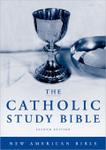As we continue profiling the Study Bibles from this month’s sale, today we will take an at-a-glance look at the Catholic Study Bible.
Title: The Catholic Study Bible
Area of Focus: Catholic Studies
Contributors: Editors Donald Senior and John J. Collins are joined by 12 other scholars who have contributed articles, notes and material for the reading guide.
Description: One of the main features of the Catholic Study Bible is an extensive Reading Guide for each book of the Bible. The Reading Guides are found at the beginning of the CSB and are designed to lead the reader through the structure and basic message of each book. Other features include complete lectionary readings for the liturgical years of the church, updated study notes for the second edition, and numerous articles covering topics such as Catholic interpretation of the Bible, challenges of biblical translation, and biblical history and archaeology.
Sample Article
The Bible in Catholic Life
by Daniel J. Harrington
In order to understand the Bible’s place in Catholic thinking today, it can be helpful to see how Christians in other times and places thought about and interpreted the Bible. The Bible has not always been studied according to the principles of modern historical criticism. Nor should scientific study of the Bible be understood as superseding, and thus making obsolete, all earlier approaches. A brief history of biblical interpretation will reveal important insights that remain valid today.
The Old Testament constituted the Bible for Jesus and the early Christians. According to the Gospels, Jesus sometimes quoted or alluded to Old Testament texts in order to establish a theological point or to suggest a way of acting. He clearly accorded these texts a certain degree of authority. Nevertheless, Jesus emerges from the New Testament as displaying flexibility toward the Old Testament and even asserting his authority over it. He distinguishes what comes from God and what comes from Moses (see Mk 10, 1–12), goes beyond certain scriptural teachings (Mt 5, 21–48), and rates love of God and neighbor (Mk 12, 28–31) over strict observance of the Sabbath.
New Testament writers such as Paul and Matthew looked upon the Old Testament Scriptures as “fulfilled” in Jesus Christ. Basing themselves on what apparently was a widespread early Christian understanding, they interpreted the Old Testament Scriptures in the light of the life, death, and resurrection of Jesus. Like other Jews of the time, they understood the Old Testament to be a “mystery”—that is, something that could not be understood without guidance or explanation. Whereas the Qumran community (the Jewish group that gave us the Dead Sea Scrolls) found the key to the Scriptures in their own sect’s history and life, the early Christians discovered Jesus to be the key that opened up the mystery of the Hebrew Bible.
By the time of the Fathers of the Church (the patristic period), the Christian Bible contained two Testaments—Old and New. These early theologians generally adopted one or the other of two basic approaches to the reading and interpretation of Scripture: the allegorical and the literal methods.
The allegorical method, favored particularly by those theologians who lived in Alexandria in Egypt, emphasized uncovering the spiritual truths beneath the surface of the biblical stories. This method had been developed by Greek thinkers who interpreted the stories in Homer’s Iliad and Odyssey as symbolizing emotional or spiritual struggles within the individual. It had also been adopted by Jewish interpreters, like Philo of Alexandria, who used the method on the Hebrew Bible in order to appeal to non–Jews and especially to Jews who had come under the influence of Greek philosophy and culture. Christian theologians who used this method included Origen and Clement of Alexandria.
In contrast to this method was the more literal reading of the Bible, favored by those Christian thinkers who lived in Antioch, the capital of Syria in Roman times. The literal approach focused more on the historical realities described in Scripture, and insisted that any higher or deeper sense should be based firmly on the literal sense of the text. John Chrysostom and Theodore of Mopsuestia were among those who favored this approach.
It is important to recognize that these different emphases were not completely opposed to each other. Thus the allegorical method did not deny the historical truth of events in Scripture, nor did the literal method deny the spiritual meaning of those events. Later theologians tended to blend the two approaches, though favoring one tendency or the other. Augustine, for instance, tended toward the allegorical and Jerome toward the literal…


